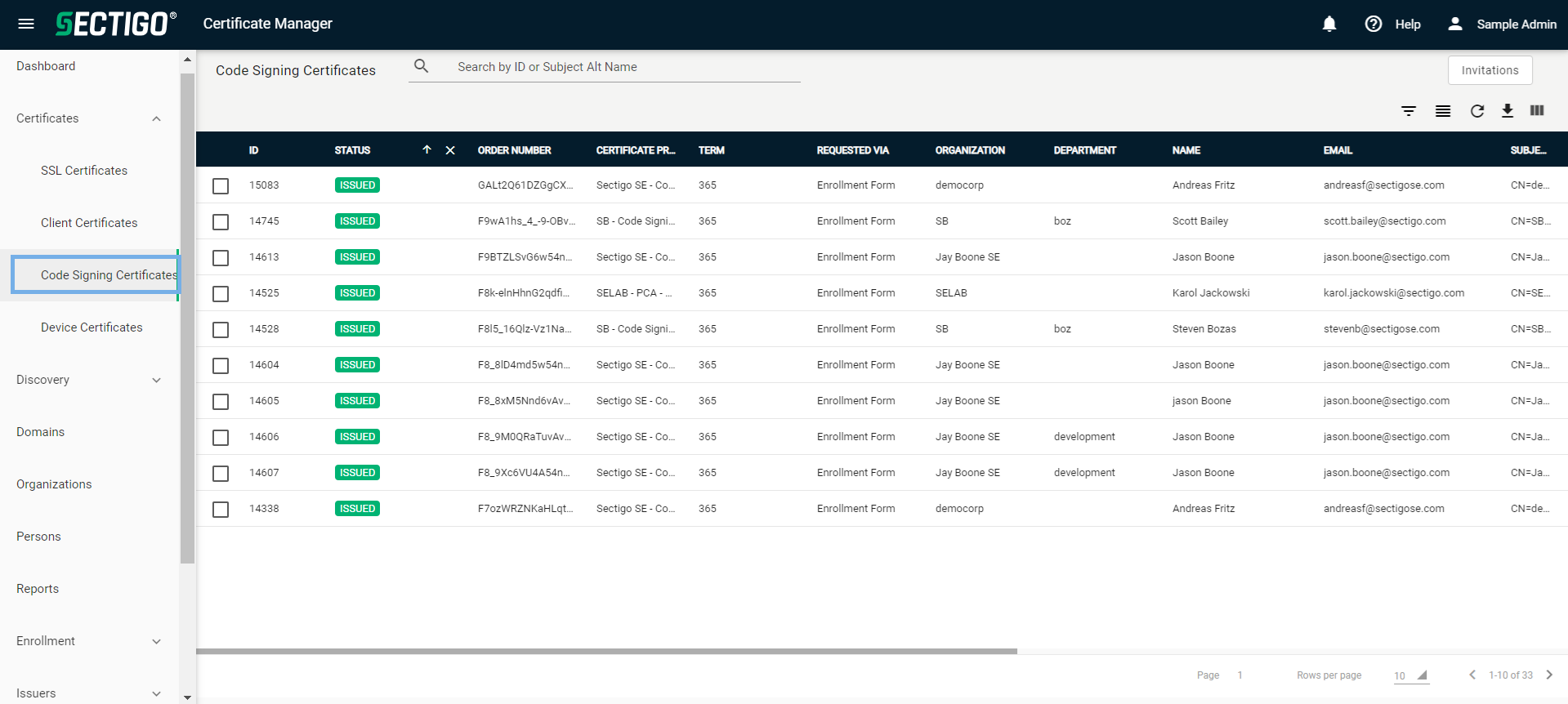Understanding code signing certificates
Code signing certificates are used to sign software and code to verify the identity of the publisher and ensure that the code has not been tampered with.
In addition to providing a centralized view of code signing certificates and certificate details, SCM enables appropriately privileged administrators to do the following:
-
Revoke certificates — Revoke code signing certificates.
-
Send enrollment invitations — Send code signing certificate self-enrollment invitations to users.
Code signing certificates can be managed on the page.

The following table describes the details and controls of the Code Signing Certificates page.
| Column | Description | ||
|---|---|---|---|
ID |
The unique numeric identifier of the certificate. |
||
Status |
The status of the certificate. The possible values are:
|
||
Order number |
The unique identifier created by the issuing CA to represent the certificate request. |
||
Certificate profile |
The certificate profile used for the certificate request. |
||
Sub type |
The validation type of the certificate. The possible values are:
|
||
Term |
The validity period of the certificate. |
||
Requested via |
The method used to request the certificate or to bring it into SCM. The possible values are:
|
||
Organization |
The organization that requested or has been issued the certificate. |
||
Department |
The department, if any, that requested or has been issued the certificate. |
||
Name |
The certificate requestor’s name. |
||
The certificate requestor’s email address. |
|||
Subject |
The entity (such as an individual or organization) identified by the certificate, containing unique attributes that distinguish it from others. |
||
Subject alt name |
Additional names or attributes that identify the entity associated with the certificate. This can include alternative email addresses, organizational unit names, or other identifiers relevant to code-signing certificates. |
||
Issuer |
The name of the certificate and the issuing CA. |
||
Expires |
The date that the certificate expires. |
||
Serial number |
A unique serial number assigned to the certificate. |
||
Key usage |
The cryptographic operations that the certificate is valid for. |
||
Extended key usage |
Additional cryptographic operations that the certificate is valid for. |
||
Key algorithm |
The algorithm used to generate the key pair. |
||
Key size / curve |
The size of the key pair or the curve used to generate the key pair. |
||
Signature algorithm |
The algorithm used to sign the certificate. |
||
MD5 hash |
The MD5 hash (thumbprint/fingerprint) of the certificate. |
||
SHA1 hash |
The SHA1 hash (thumbprint/fingerprint) of the certificate. |
||
Requested |
The date that the certificate was requested. |
||
Issued |
The date that the certificate was issued. |
||
Downloaded |
The date that the certificate was downloaded. |
||
Revoked |
The date that the certificate was revoked. |
||
Deleted |
The date that the certificate entry was deleted. |
||
HSM type |
The type of hardware security module (HSM) used to store the certificate. The currently supported HSM types are:
|
||
Shipping type |
The shipping method used to deliver the certificate. |
||
Custom fields |
Depending on your configuration, various custom field columns may be available containing additional information about the certificate. |
||
Table controls |
|||
Quick Search |
Enables you to quickly search the results by ID, or Subject Alternative Name. |
||
Filter |
Enables you to sort the table information using custom filters. |
||
Group |
Enables you to sort the table information using predefined groups. |
||
Refresh |
Refreshes the information presented in the table. |
||
Download CSV |
Downloads the table information as a |
||
Manage Columns |
Enables you to select which table columns to display. |
||
Admin controls |
|||
Invitations |
Opens the Invitations dialog where you can invite users to request certificates through an external enrollment form. |
||
Delete |
Opens the Delete Certificate dialog where you can delete the certificate entry from SCM. |
||
View |
Opens the Code Signing Certificate page where you can view certificate details and perform various administrative tasks (such as downloading the certificate). |
||
Revoke |
Opens the Revocation Reason dialog where you can revoke the certificate. |
||
View Audit |
Opens the Certificate Audit page where you can view or download audit logs. |
||
Enrollment methods
SCM supports the enrollment of code signing certificates using the following methods:
-
Self-Enrollment — Manually enroll code signing certificates using a self-enrollment form outside of SCM. For more information, see Understanding enrollment forms.
-
REST API — Enroll code signing certificates through the SCM REST API using a configured SCM REST API endpoint. For more information, see Understanding REST endpoints.
-
Admin API — Enroll code signing certificates through the SCM Admin API using a configured SCM API Admin. For more information, see Understanding administrators.
-
CA connector — Enroll code signing certificates through a third-party CA using a configured SCM CA connector. For more information, see Understanding CA connectors.